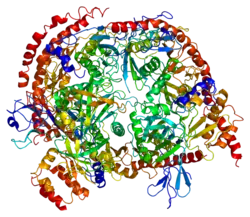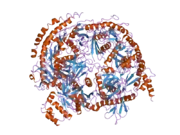Exosome complex exonuclease MTR3 is an enzyme that in humans is encoded by the EXOSC6 gene.[5][6][7]
This gene product constitutes one of the subunits of the multisubunit particle called the exosome complex, which mediates mRNA degradation. The composition of human exosome is similar to its yeast counterpart. This protein is homologous to the yeast Mtr3 protein. Its exact function is not known, however, it has been shown using a cell-free RNA decay system that the exosome is required for rapid degradation of unstable mRNAs containing AU-rich elements (AREs), but not for poly(A) shortening. The exosome does not recognize ARE-containing mRNAs on its own, but requires ARE-binding proteins that could interact with the exosome and recruit it to unstable mRNAs, thereby promoting their rapid degradation.[7]
Interactions
Exosome component 6 has been shown to interact with Exosome component 7,[6]Exosome component 8[6] and Exosome component 1.[6]
References
- 1 2 3 GRCh38: Ensembl release 89: ENSG00000223496 - Ensembl, May 2017
- 1 2 3 GRCm38: Ensembl release 89: ENSMUSG00000109941 - Ensembl, May 2017
- ↑ "Human PubMed Reference:". National Center for Biotechnology Information, U.S. National Library of Medicine.
- ↑ "Mouse PubMed Reference:". National Center for Biotechnology Information, U.S. National Library of Medicine.
- ↑ Chen CY, Gherzi R, Ong SE, Chan EL, Raijmakers R, Pruijn GJ, Stoecklin G, Moroni C, Mann M, Karin M (Nov 2001). "AU binding proteins recruit the exosome to degrade ARE-containing mRNAs". Cell. 107 (4): 451–64. doi:10.1016/S0092-8674(01)00578-5. PMID 11719186. S2CID 14817671.
- 1 2 3 4 Raijmakers R, Egberts WV, van Venrooij WJ, Pruijn GJ (Nov 2002). "Protein-protein interactions between human exosome components support the assembly of RNase PH-type subunits into a six-membered PNPase-like ring". J Mol Biol. 323 (4): 653–63. doi:10.1016/S0022-2836(02)00947-6. PMID 12419256.
- 1 2 "Entrez Gene: EXOSC6 exosome component 6".
Further reading
- Lehner B, Sanderson CM (2004). "A protein interaction framework for human mRNA degradation". Genome Res. 14 (7): 1315–23. doi:10.1101/gr.2122004. PMC 442147. PMID 15231747.
- Ota T, Suzuki Y, Nishikawa T, et al. (2004). "Complete sequencing and characterization of 21,243 full-length human cDNAs". Nat. Genet. 36 (1): 40–5. doi:10.1038/ng1285. PMID 14702039.
- Strausberg RL, Feingold EA, Grouse LH, et al. (2003). "Generation and initial analysis of more than 15,000 full-length human and mouse cDNA sequences". Proc. Natl. Acad. Sci. U.S.A. 99 (26): 16899–903. Bibcode:2002PNAS...9916899M. doi:10.1073/pnas.242603899. PMC 139241. PMID 12477932.
- van Hoof A, Parker R (2002). "Messenger RNA degradation: beginning at the end". Curr. Biol. 12 (8): R285–7. doi:10.1016/S0960-9822(02)00802-3. PMID 11967169. S2CID 17142692.
- Raijmakers R, Noordman YE, van Venrooij WJ, Pruijn GJ (2002). "Protein-protein interactions of hCsl4p with other human exosome subunits". J. Mol. Biol. 315 (4): 809–18. doi:10.1006/jmbi.2001.5265. PMID 11812149.
- Brouwer R, Allmang C, Raijmakers R, et al. (2001). "Three novel components of the human exosome". J. Biol. Chem. 276 (9): 6177–84. doi:10.1074/jbc.M007603200. hdl:2066/186951. PMID 11110791.





